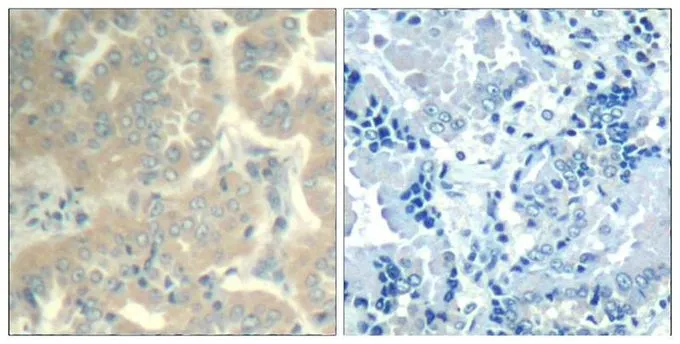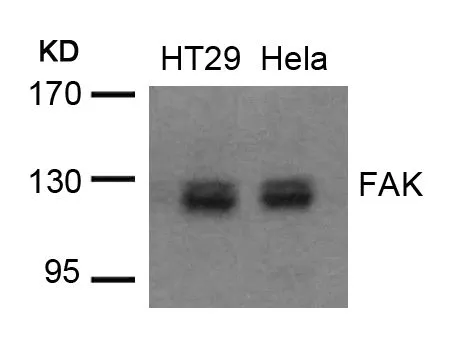
IHC-P analysis of human lung carcinoma tissue using GTX50666 FAK antibody. Left : Primary antibody Right : Primary antibody pre-incubated with the antigen specific peptide
FAK antibody
GTX50666
ApplicationsWestern Blot, ImmunoHistoChemistry, ImmunoHistoChemistry Paraffin
Product group Antibodies
ReactivityHuman
TargetPTK2
Overview
- SupplierGeneTex
- Product NameFAK antibody
- Delivery Days Customer9
- Application Supplier NoteWB: 1:500-1:1000. IHC-P: 1:50-1:100. *Optimal dilutions/concentrations should be determined by the researcher.Not tested in other applications.
- ApplicationsWestern Blot, ImmunoHistoChemistry, ImmunoHistoChemistry Paraffin
- CertificationResearch Use Only
- ClonalityPolyclonal
- Concentration1 mg/ml
- ConjugateUnconjugated
- Gene ID5747
- Target namePTK2
- Target descriptionprotein tyrosine kinase 2
- Target synonymsFADK; FADK 1; FAK; FAK1; FAK-related non-kinase polypeptide; focal adhesion kinase 1; focal adhesion kinase-related nonkinase; FRNK; p125FAK; pp125FAK; PPP1R71; protein phosphatase 1 regulatory subunit 71; PTK2 protein tyrosine kinase 2
- HostRabbit
- IsotypeIgG
- Protein IDQ05397
- Protein NameFocal adhesion kinase 1
- Scientific DescriptionThis gene encodes a cytoplasmic protein tyrosine kinase which is found concentrated in the focal adhesions that form between cells growing in the presence of extracellular matrix constituents. The encoded protein is a member of the FAK subfamily of protein tyrosine kinases but lacks significant sequence similarity to kinases from other subfamilies. Activation of this gene may be an important early step in cell growth and intracellular signal transduction pathways triggered in response to certain neural peptides or to cell interactions with the extracellular matrix. Several transcript variants encoding different isoforms have been found for this gene. [provided by RefSeq, Jun 2017]
- ReactivityHuman
- Storage Instruction-20°C or -80°C,2°C to 8°C
- UNSPSC12352203
References
- Increased expression of FAK isoforms as potential cancer biomarkers in ovarian cancer. Nolasco-Quiroga M et al., 2019 Jun, Oncol LettRead more

